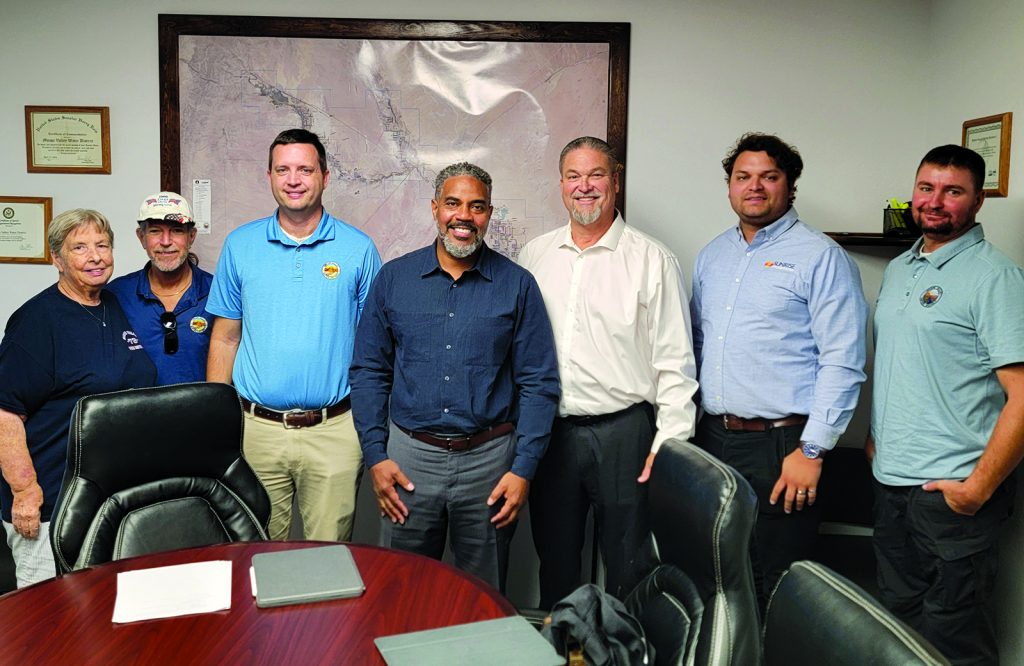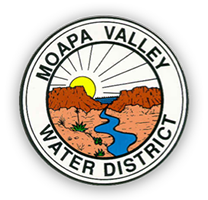
Horsford meets with local water officials
Rep. Steven Horsford had a meeting with culinary water officials from both Moapa Valley Water District (MVWD) and Virgin Valley Water District (VVWD) last week in Overton to receive an update on federal infrastructure grants set aside for both entities and to discuss best practices in pursuing other federal grant programs in the future. The meeting was held on Wednesday morning, Oct. 9, in the MVWD board room.
Horsford congratulated both districts on their successful federal grant applications. In December of 2022, both districts were named in a $1.7 trillion omnibus infrastructure bill. The local grants were distributed from a $1.47 billion EPA community grant program that was a component part of that major bill.
MVWD received $2.4 million to help replace a vital 24-inch water transmission line connecting the lower valley communities with the district’s water production facilities in the Warm Springs area. Originally constructed in 1996, the ductile iron pipeline was apparently installed improperly. Nearly three decades later, this essential line has fallen victim to corrosion and failure.
“I wanted to just stop by and get an update on how these funds will benefit the community and what more we need to do to make sure things continue to move forward, and don’t get bogged down in bureaucratic red tape,” Horsford said.
Horsford stated that the MVWD grant was among 715 approved water infrastructure projects in the bill. Thus, the field had been very competitive, he said.
“You did a great job of getting your submission in and making sure that it met the criteria,” Horsford said. “I just want to commend you, because it is to communities like this that these infrastructure funds really need to go. In a way, you are a model of how these programs can work.”
MVWD officials expressed appreciation to Horsford for his role in bringing the funding to these high priority local projects.
“It was extremely fortunate that we could have a conversation with you and your staff,” said MVWD general manager Joe Davis. “We really appreciate your support.”
“This project wasn’t even on our radar,” Davis added. “When things started failing on that line, we realized that we would have to focus our resources on it. We had two other major projects in the queue. But we were afraid that we would have to drop those for a while. With this funding, though, we can maintain our timeline instead of pushing important projects back four or five years.”
Officials from both entities talked about delays seen along the way. Neither district has actually received the grant funding to date. Problems in the process and federal requirements had placed roadblocks along the way. Thus, both entities have been waiting for the funding to move forward with their projects.
But both MVWD and VVWD officials emphasized that Horsford and his staff have been quite helpful along the way. He has continued to move the process through the difficulties, they said. All were confident that the funds would eventually be disbursed to begin the projects.
“We have all learned a lot along the way that will help us in the next round of funding,” Horsford said.
Another topic Horsford was curious about was the economic benefits that will come to the communities due to these projects.
Davis said that MVWD tends to hire local contractors to complete the work on these types of projects. “We have found that the local companies actually sharpen their pencils pretty well,” Davis said. “And the majority of their crews are living here and spending their earnings here. So it becomes a major benefit to the local economy.”
Horsford also asked how the projects would be sustainable for the future. In response, Davis talked about the unique challenge of being a rural utility with the task of providing water to a relatively small community through a large system.
“We have 210 miles of pipe in our system,” Davis said. “That is about the same as what Virgin Valley has. But the cost of maintaining and growing that line is distributed to less than 3,200 connections in Moapa Valley, whereas Virgin Valley has over 10,000. So, we have to spread that cost over a much smaller customer base. Instead of looking at a 4 percent rate increase to do projects like this; we might be looking at something like 10-12 percent. And that is a real burden for our ratepayers.”
Horsford concluded by saying that this input was helpful information to use when the next round of grant funding comes around.
“Eventually this program will come up for renewal,” he said. “And making these arguments along the way, identifying best practices of what worked and what didn’t, will help me when the opportunity comes up again. We have to be able to prove our concept, particularly for rural and underserved communities.”

